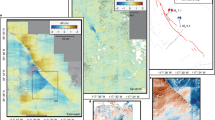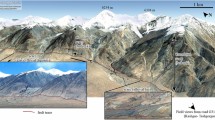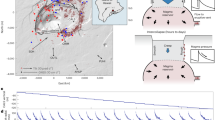Abstract
Inelastic processes from earthquakes contribute to the formation of fault damage zones that constitute a permanent sink of strain energy, modify the elastic properties of the shallow crust and amplify near-field ground shaking. Constraints on the extent of inelastic deformation differ depending on the dataset and methodology used. Here we combine fracture, strain and aftershock maps from the 2019 Ridgecrest earthquakes to reconcile the properties of damage zones across different spatial scales and resolutions. The decay of inelastic deformation with distance from the fault is well described by an inverse power law, extends beyond 20 km from the faults and is insensitive to lithology and slip magnitude. The damage decay is continuous without breaks in scaling, suggesting that a single mechanism dominates yielding. On the basis of our fracture density distribution, we predict an average reduction in shear rigidity of about 20% in bedrock and 40% in alluvium immediately adjacent to the fault, declining to less than 1% at 100 m. Our observations reveal how macroscopic fracturing generates intense near-fault damage and that widespread damage accrues regionally over multiple earthquake cycles.
This is a preview of subscription content, access via your institution
Access options
Access Nature and 54 other Nature Portfolio journals
Get Nature+, our best-value online-access subscription
$29.99 / 30 days
cancel any time
Subscribe to this journal
Receive 12 print issues and online access
$259.00 per year
only $21.58 per issue
Buy this article
- Purchase on Springer Link
- Instant access to full article PDF
Prices may be subject to local taxes which are calculated during checkout




Similar content being viewed by others
Data availability
The datasets generated in this manuscript are available for download from https://github.com/absrp/damage_datasets. All datasets used in this manuscript are open access. The foreshock UAV imagery from ref. 28 is available from https://doi.org/10.5069/G9KD1W2C. The mainshock UAV imagery is available from https://doi.org/10.5069/G9930RBB. The aerial photography and lidar data from ref. 25 are available from https://doi.org/10.5069/G9W0942Z. The Ridgecrest QTM earthquake catalogue is available from https://scedc.caltech.edu/data/qtm-ridgecrest.html. The SCSN catalogue is available from https://www.scsn.org/. The field- and geodesy-based rupture map from ref. 26 is available from https://www.sciencebase.gov/catalog/item/5d699da6e4b0c4f70cf2f936. The shapefile containing the high-resolution fracture maps from ref. 27 is available from https://sandbox.zenodo.org/record/902426#.YSAyW9NKiDU. The 3D representations of the fault planes from ref. 30 are available from the SCEC community fault model: https://www.scec.org/research/cfm.
Code availability
The code used to fit and analyse the data is available from the corresponding author upon request.
References
Loveless, J. P. & Meade, B. J. Geodetic imaging of plate motions, slip rates, and partitioning of deformation in Japan. J. Geophys. Res. Solid Earth 115, B02410 (2010).
Evans, E. L., Thatcher, W. R., Pollitz, F. F. & Murray, J. R. Persistent slip rate discrepancies in the eastern California (USA) shear zone. Geology 44, 691–694 (2016).
Shelef, E. & Oskin, M. Deformation processes adjacent to active faults: examples from eastern California. J. Geophys. Res. Solid Earth 115, B05308 (2010).
Milliner, C. W. D., Dolan, J. F., Hollingsworth, J., Leprince, S. & Ayoub, F. Comparison of coseismic near-field and off-fault surface deformation patterns of the 1992 Mw 7.3 Landers and 1999 Mw 7.1 Hector Mine earthquakes: implications for controls on the distribution of surface strain. Geophys. Res. Lett. 43, 10115–10124 (2016).
Scott, C. P. et al. The M 7 2016 Kumamoto, Japan, earthquake: 3D deformation along the fault and within the damage zone constrained from differential lidar topography. J. Geophys. Res. Solid Earth 123, 6138–6155 (2018).
Shipton, Z. K., Evans, J. P., Abercrombie, R. E. & Brodsky, E. E. in Earthquakes: Radiated Energy and the Physics of Faulting (eds Abercrombie, R. et al.) 217–222 (American Geophysical Union, 2006).
Dolan, J. F. & Haravitch, B. D. How well do surface slip measurements track slip at depth in large strike-slip earthquakes? The importance of fault structural maturity in controlling on-fault slip versus off-fault surface deformation. Earth Planet. Sci. Lett. 388, 38–47 (2014).
Cochran, E. S. et al. Seismic and geodetic evidence for extensive, long-lived fault damage zones. Geology 37, 315–318 (2009).
Brock, W. G. & Engelder, T. Deformation associated with the movement of the Muddy Mountain overthrust in the Buffington window, southeastern Nevada. Geol. Soc. Am. Bull. 88, 1667–1677 (1977).
Chester, J. S., Chester, F. M. & Kronenberg, A. K. Fracture surface energy of the Punchbowl fault, San Andreas system. Nature 437, 133–136 (2005).
Mitchell, T. M. & Faulkner, D. R. The nature and origin of off-fault damage surrounding strike-slip fault zones with a wide range of displacements: a field study from the Atacama fault system, northern Chile. J. Struct. Geol. 31, 802–816 (2009).
Savage, H. M. & Brodsky, E. E. Collateral damage: evolution with displacement of fracture distribution and secondary fault strands in fault damage zones. J. Geophys. Res. Solid Earth 116, B03405 (2011).
Powers, P. M. & Jordan, T. H. Distribution of seismicity across strike-slip faults in California. J. Geophys. Res. Solid Earth 115, B05305 (2010).
Perrin, C., Waldhauser, F. & Scholz, C. H. The shear deformation zone and the smoothing of faults with displacement. J. Geophys. Res. Solid Earth 126, e2020JB020447 (2021).
Fialko, Y. Probing the mechanical properties of seismically active crust with space geodesy: study of the coseismic deformation due to the 1992 Mw 7.3 Landers (Southern California) earthquake. J. Geophys. Res. Solid Earth 109, B03307 (2004).
Barnhart, W. D., Gold, R. D. & Hollingsworth, J. Localized fault-zone dilatancy and surface inelasticity of the 2019 Ridgecrest earthquakes. Nat. Geosci. 13, 699–704 (2020).
Milliner, C. et al. Bookshelf kinematics and the effect of dilatation on fault zone inelastic deformation: examples from optical image correlation measurements of the 2019 Ridgecrest earthquake sequence. J. Geophys. Res. Solid Earth 126, e2020JB020551 (2021).
Antoine, S. L. et al. Diffuse deformation and surface faulting distribution from submetric image correlation along the 2019 Ridgecrest, California, ruptures. Bull. Seismol. Soc. Am. 111, 2275–2302 (2021).
Li, Y.-G., Chen, P., Cochran, E. S., Vidale, J. E. & Burdette, T. Seismic evidence for rock damage and healing on the San Andreas fault associated with the 2004 M 6.0 Parkfield earthquake. Bull. Seismol. Soc. Am. 96, S349–S363 (2006).
Qiu, H. et al. Seismic imaging of the Mw 7.1 Ridgecrest earthquake rupture zone from data recorded by dense linear arrays. J. Geophys. Res. Solid Earth 126, e2021JB022043 (2021).
Ross, Z. E. et al. Hierarchical interlocked orthogonal faulting in the 2019 Ridgecrest earthquake sequence. Science 366, 346–351 (2019).
Liu, C., Lay, T., Brodsky, E. E., Dascher-Cousineau, K. & Xiong, X. Coseismic rupture process of the large 2019 Ridgecrest earthquakes from joint inversion of geodetic and seismological observations. Geophys. Res. Lett. 46, 11820–11829 (2019).
Fialko, Y. & Jin, Z. Simple shear origin of the cross-faults ruptured in the 2019 Ridgecrest earthquake sequence. Nat. Geosci. 14, 513–518 (2021).
Xu, X. et al. Surface deformation associated with fractures near the 2019 Ridgecrest earthquake sequence. Science 370, 605–608 (2020).
Hudnut, K. W. et al. Airborne lidar and electro‐optical imagery along surface ruptures of the 2019 Ridgecrest earthquake sequence, Southern California. Seismol. Res. Lett. 91, 2096–2107 (2020).
Ponti, D. J. et al. Documentation of surface fault rupture and ground‐deformation features produced by the 4 and 5 July 2019 Mw 6.4 and Mw 7.1 Ridgecrest earthquake sequence. Seismol. Res. Lett. 91, 2942–2959 (2020).
Rodriguez Padilla, A. M. et al. Near-field high-resolution maps of the Ridgecrest earthquakes from aerial imagery. Seismol. Res. Lett. 93, 494–499 (2022).
Pierce, I., Williams, A., Koehler, R. D. & Chupik, C. High‐resolution structure‐from‐motion models and orthophotos of the southern sections of the 2019 Mw 7.1 and 6.4 Ridgecrest earthquakes surface ruptures. Seismol. Res. Lett. 91, 2124–2126 (2020).
Hauksson, E. et al. Caltech/USGS Southern California Seismic Network (SCSN) and Southern California Earthquake Data Center (SCEDC): data availability for the 2019 Ridgecrest sequence. Seismol. Res. Lett. 91, 1961–1970 (2020).
Plesch, A., Shaw, J. H., Ross, Z. E. & Hauksson, E. Detailed 3D fault representations for the 2019 Ridgecrest, California, earthquake sequence. Bull. Seismol. Soc. Am. 110, 1818–1831 (2020).
Felzer, K. R. & Brodsky, E. E. Decay of aftershock density with distance indicates triggering by dynamic stress. Nature 441, 735–738 (2006).
Richards-Dinger, K., Stein, R. S. & Toda, S. Decay of aftershock density with distance does not indicate triggering by dynamic stress. Nature 467, 583–586 (2010).
Budiansky, B. & O’connell, R. J. Elastic moduli of a cracked solid. Int. J. Solids Struct. 12, 81–97 (1976).
Zhou, Z., Bianco, M., Gerstoft, P. & Olsen, K. High‐resolution imag ing of complex shallow fault zones along the July 2019 Ridgecrest ruptures. Geophys. Res. Lett. 49, e2021GL095024 (2022).
Lu, Y. & Ben-Zion, Y. Regional seismic velocity changes following the 2019 Mw 7.1 Ridgecrest, California earthquake from autocorrelations and P/S converted waves. Geophys. J. Int. 228, 620–630 (2021).
Leprince, S., Barbot, S., Ayoub, F. & Avouac, J.-P. Automatic and precise orthorectification, coregistration, and subpixel correlation of satellite images, application to ground deformation measurements. IEEE Trans. Geosci. Remote Sens. 45, 1529–1558 (2007).
Foreman-Mackey, D., Hogg, D. W., Lang, D. & Goodman, J. emcee: the MCMC hammer. Publ. Astron. Soc. Pac. 125, 306–312 (2013).
Goodman, J. & Weare, J. Ensemble samplers with affine invariance. Comm. App. Math. Comp. Sci. 5, 65–80 (2010).
Acknowledgements
We thank the UCSC seismo lab and Y. Ben-Zion for helpful discussion. This research was supported by the Southern California Earthquake Center (contribution no. 10995). SCEC is funded by NSF Cooperative Agreement EAR-1600087 and USGS Cooperative Agreement G17AC00047. A.M.R.P is supported by NASA FINESST fellowship 20-EARTH20-0313.
Author information
Authors and Affiliations
Contributions
A.M.R.P mapped fractures from lidar data and prepared and processed the data for the damage decay analysis. M.E.O. and A.M.R.P computed the modulus decrease estimates. C.W.D.M. computed strain and generated the strain profiles. A.P. measured the distance between the aftershocks and the fault planes. All authors contributed to writing the manuscript.
Corresponding author
Ethics declarations
Competing interests
The authors declare no competing interests.
Peer review
Peer review information
Nature Geoscience thanks Christopher Scholz and the other, anonymous, reviewer(s) for their contribution to the peer review of this work. Primary Handling Editor: Rebecca Neely in collaboration with the Nature Geoscience team.
Additional information
Publisher’s note Springer Nature remains neutral with regard to jurisdictional claims in published maps and institutional affiliations.
Extended data
Extended Data Fig. 1 Stacked profiles of fault-parallel shear strain from satellite cross-correlated imagery.
Stacked profiles of fault-parallel shear strain from satellite cross-correlated imagery17. Each profile stacks horizontal fault-parallel displacement over a 138-meter window along strike. Strain is then calculated from the fault-parallel displacement profile over a 12-meter kernel across strike by taking the first derivative using a central-difference finite approximation.
Extended Data Fig. 2 Decay in aftershock density with fault-perpendicular distance for different depth intervals.
Top: Decay in aftershock density with fault-perpendicular distance for different depth intervals. The vertical lines represent the break in scaling d for each group of aftershocks. Bottom: Range of γ and d fits. The vertical lines represent the maximum likelihood value.
Extended Data Fig. 3 Maximum likelihood distribution of parameters in Eq. (1) for the distributions in Fig. 3 (main).
Top: Fit range (histograms) for parameters d and γ in Eq. (1) for the bedrock and sediment distributions in Fig. 3 of the manuscript. Bottom: fit range for parameters d and γ in Eq. (1) for zones 1 through 5 in Fig. 3 of the manuscript. The vertical lines represent the maximum likelihood value. The shaded orange section indicates the fault location uncertainty at the surface.
Extended Data Fig. 4 Distribution of fracture orientation with fault-perpendicular distance.
Distribution of fracture orientation with distance away from the fault for zones 1–5 from top to bottom (Fig. 3). Fractures are shown in color and faults are shown in grey. Fracture orientation abundances are normalized by the total number of fractures in the rose diagram.
Extended Data Fig. 5 Map view of fracture orientations at select locations.
Map view of fracture orientations. A, B, and C show the distribution of fractures through zones 1, 4, and 5 in Fig. 3. D and E show insets into regions of A and C to highlight variability along the rupture and organization of fractures at narrow angles from one another.
Extended Data Fig. 6 Strain and fracture density maps.
Strain and fracture density maps from high-resolution imagery for the middle of the foreshock (a and b) and the southern tip of the mainshock (c and d). Strain is calculated over a 12-meter kernel and fracture density is calculated over a 10 meter kernel.
Supplementary information
Supplementary Information
Supplementary Figs. 1–17 and derivation for equations (1)–(13).
Rights and permissions
About this article
Cite this article
Rodriguez Padilla, A.M., Oskin, M.E., Milliner, C.W.D. et al. Accrual of widespread rock damage from the 2019 Ridgecrest earthquakes. Nat. Geosci. 15, 222–226 (2022). https://doi.org/10.1038/s41561-021-00888-w
Received:
Accepted:
Published:
Issue Date:
DOI: https://doi.org/10.1038/s41561-021-00888-w
This article is cited by
-
The impact of faulting complexity and type on earthquake rupture dynamics
Communications Earth & Environment (2022)
-
A Synthesis of Fracture, Friction and Damage Processes in Earthquake Rupture Zones
Pure and Applied Geophysics (2022)



